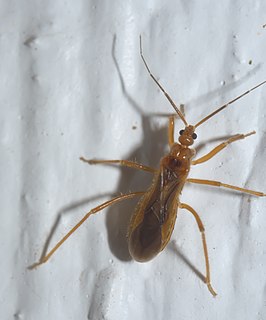Ghilianella is a genus of true bug in the subfamily Emesinae. Fifty-eight species have been described, with a distribution from Guatemala to Brazil. The linear form of the species in this genus allow the young larvae to be carried about by the mother or perhaps the father. The larvae of the young can curl around the parent's thorax.

Stenolemus is a genus of thread-legged bug (Emesinae). Species of this genus are noted for preying on spiders.
Polauchenia is a genus of thread-legged bug (Emesinae). Only five species have been described.
Phasmatocoris is a little-known genus of thread-legged bug (Emesinae). Fourteen species have been described, including 3 from Colombia.

The Ectrichodiinae are a subfamily of assassin bugs (Reduviidae) known for specializing on millipedes as prey. The group comprises more than 600 species in about 115 genera, making it a fairly large subfamily. The bugs are also known for their aposematic coloration, often brightly colored metallic blue, red, or yellow.

Harpactorini is a tribe of the Harpactorinae. This group is the most diverse of the entire assassin bug family, with 51 genera recognized in the Neotropical Region and 289 genera and 2003 species overall.

The Bactrodinae are a small subfamily of the reduviid. Only one genus and five species have been described to date, all from the Neotropical Region. These bugs are slender and long-legged, the first antennal segment is long and the eyes jut out. They also have ocelli placed on raised protrusions.
Emesa is a small genus of thread-legged bug (Emesinae). Only four species have been described.
Phasmatocoris spectrum is a thread-legged bug species from the genus Phasmatocoris. It is found in South America, having been recorded in Brazil, Colombia, Bolivia, and Venezuela. The Colombia record was taken from a “Palma Real” tree in the forest interior. Phasmatocoris papei sp. nov. is described from French Guiana based on two male specimens. Short taxonomical notes on Phasmatocoris praecellens and Ph. spectrum Breddin, 1904 are provided. An updated key to the species of Phasmatocoris Breddin, 1904 is presented.
Agriocleptus is a small genus of assassin bugs.
Agriocoris flavipes is an assassin bug in the monotypic genus of Agriocoris, belonging to the family Reduviidae. It is widely distributed throughout Central and South America.
Amauroclopius is a small genus of assassin bugs belonging to the family Reduviidae.
Beharus is a monotypic genus of assassin bugs belonging to the family Reduviidae. Its one species, B. cylindripes, is found in South America, though not restricted to the Amazon basin.
Heniartes is a large genus of assassin bugs belonging to the family Reduviidae; 32 species have been described, all from South America.
Cosmoclopius is a genus of South American assassin bugs, in the subfamily Harpactorinae.

The Reduviinae are a subfamily of the reduviid assassin bugs. Many members of the subfamily are nocturnal and their lifecycles are generally poorly known. This subfamily is suspected not to be monophyletic.

Saicinae is a subfamily of the family Reduviidae, or the assassin bugs.
Tagalis is a genus of assassin bugs in the family Reduviidae.

Bactrodes is a genus of reduviids. All known species are from South America.

Oncerotrachelus is a genus of assassin bugs in the family Reduviidae. There are about 14 described species in Oncerotrachelus.







